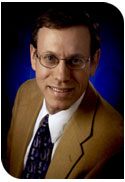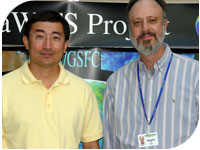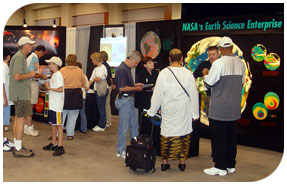 |
| volume 1, number 3 : fall 2003 |
[Download free Acrobat Reader] |
|||||||||||||
| Contents: HQ Names a New Director for Technology Transfer Goddard Researchers Receive Software of the Year Award the tech transfer process: Step 2: Technology Assessment researcher profile: W. Dan Powell events: Building Business Relationships at NASA Conference Goddard Outreach to the Public Show Off Your Innovations at Next Year’s NDES SAM Tech Transfer Success Video Tech Transfer Metrics - July 1 - September 30, 2003 Send Us Your Ideas Submit Your New Technologies |
HQ Names a New Director for Technology Transfer
Newly renamed the Innovative Technology Transfer Partnerships Division (ITTP), technology transfer is focusing on spin-in as well as spin-out. "The goal of ITTP is to form partnerships with industry and academia to develop new technology that supports Enterprise programs," explained Mr. Neumann. "We also will commercialize and transfer NASA technology to U.S. industry and enhance NASA technology and commercial objectives."Industry and academia serve as valuable resources for NASA. Often their technologies can be adapted to address space mission needs, allowing NASA to achieve its goals faster and more efficiently. At the same time, space program technologies can play an important role in the U.S. economy. "Although the structure of our economy has changed dramatically since NASA’s founding in 1958, the value and applicability of our R&D activities to the economy have remained constant," said Mr. Neumann. "Technology developed for aerospace applications often can be beneficially applied in other industries. Whether it is NASA working in tandem with private industry or the commercial sector turning to NASA for technological assistance, aerospace technologies have found their way into new products and services." You, NASA’s researchers, have an important role to play in ITTP’s mission. Whether turning to industry for new solutions or introducing space innovations to the marketplace, we look forward to working with you as NASA moves ahead with this new vision for technology transfer. |
|||||||||||||
Goddard Researchers Receive Software of the Year AwardCivil servants Charles McClain (Code 970) and Gene Feldman (Code 902) and contractors Mark Ruebens (HCI) and Xiao-Long Wang, Gary Fu, Karen Baith, and Bryan Franz (SAIC) were co-winners of the 2003 NASA Software of the Year Award for their SeaWiFS Data Analysis System (SeaDAS).
"Since the beginning of the SeaWiFS project in 1991, a primary objective has been to provide the Earth science community with rapid and easy access to the sensor’s data as well as the tools to work with the data," said Charles McClain, who heads the joint SeaWiFS-SIMBIOS Project Office. "The SeaDAS software package provides essential processing, display, analysis, and quality control functions for the data users." Feedback from the research community on SeaDAS’s performance has been extremely favorable. It has been accepted as the standard ocean color satellite analysis system by the international research community (over 500 user sites in nearly 50 countries) and other space agencies. The software also has been used by many commercial entities, including ORBIMAGE, which is developing commercial products from SeaWiFS data, and SeaSpace and Integral System, Inc., which use SeaDAS as part of their direct-broadcast ground stations. To apply for this and other NASA Space Act Awards, innovators must complete a New Technology Report (NTR) via form 1679 or the online eNTRe system and a Space Act Award Application via NF 1329, which can downloaded from the NASA Inventions and Contributions Board Web site. Submit both forms to the Innovative Partnerships Program Office (Code 504). |
||||||||||||||
|
|
||||||||||||||
|
What is a technology assessment?
A technology assessment is a detailed, in-depth examination of the potential success for transfer of a NASA innovation into a non-NASA application, known as spin-out. Perhaps an optics technology can be applied to medical imaging. Or a data processing system to urban planning. Or a mechanical innovation to home appliances or cars. The assessor conducts research to evaluate these options carefully and objectively. Also evaluated are the opportunities to spin-back the technology, applying the commercial product to NASA’s mission.
Assessments also are used to evaluate the transfer of a non-NASA technology for the space program, known as a spin-in. Future issues of Goddard Tech Transfer News will explore the technology spin-in process.
Do all Goddard innovations receive an assessment?
Unfortunately, the cost of detailed information gathering prohibits the assessment of every technology. Therefore, every innovation is screened according to preliminary criteria, including (1) Can the intellectual property be protected (i.e., patent or copyright) or have the details been publicly disclosed? (2) Is the innovation revolutionary? (3) Are there obvious applications for it? (4) What is the stage of development? According to the results of these and other criteria, the innovation may be selected for assessment.
Do I participate in the assessment?
Yes! We depend on inventors to provide us with valuable information that starts us in the assessment process. We will interview you about the key information on your NTR:
- What are your technology’s unique advantages and shortcomings?
- Do you foresee any non-NASA applications for it?
- Do you know of any other near- or long-term NASA applications?
- What issues might need to be addressed before it could be used in these applications?
Including complete information on your NTR will help.
What other information is gathered?
Your information is supplemented by the expertise of Office staff as well as research into the literature and interviews with technical experts, university professors and researchers, industry analysts and consultants, potential licensees and end users, and others. These resources provide data and feedback on the characteristics of the potential market(s) where the technology might be used, the technologies already available, patentability issues, and more. Office staff analyze this information to determine the assessment outcome.
What are the possible outcomes from the assessment?
The innovation might be recommended for patenting and the next step of the technology transfer process (Seeking a Partner/Licensee). The assessment also might show that it should be promoted by publishing articles in NASA Tech Briefs and other relevant journals. Also, during this process, your innovation will be considered for several prestigious awards. If a technology is still in the "idea phase," the Office might wait for further development or look into ways to provide additional project funding.
Spin-back and/or spin-in options as well as potential partners for joint R&D might be identified. In some cases, the assessment might recommend not pursuing further transfer efforts.
Next issue - Step 3: Seeking a Partner/Licensee

researcher profile:
W. Dan Powell
 |
Code 542 Education: B.S., mechanical engineering, Oregon State University, 2000 Born: Carmel, California |
What invention are you currently working to transfer?
I’m working on several inventions, but they are not quite ready for transfer yet. Instead, the Office has been supporting promotion of GSFC nanotechnology research in general.
What has the Innovative Partnerships Program Office done to introduce nanotechnology to new users?
The Office offered me an opportunity to present on several of my current efforts at the NASA Tech Briefs Nanotech 2003 conference on October 23. And they interviewed me for an article submitted to Nanotech Briefs. They also are working on a short video that I am part of about NASA’s nanotechnology research.
What do you see as the future for nanotechnology?
We’re working on an improved thermal interface for the next Hubble servicing mission. If it works, it will be the first useful application of nanotechnology in space and should open a lot of doors for new application development. Because most nanotechnology devices and system architectures are inherently low mass, low power, high precision, and potentially multifunctional, it promises to be ubiquitous and remake entire industries and our world.

Events
Building Business Relationships at NASA Conference
|
|
"The FLC meetings allow us to share best practices with other research labs," said Ms. Cheeks. "Doing so helps all of us to continually improve the technology transfer process and reach the goals of all our stakeholders."
Goddard Outreach to the Public
|
|
As members of Goddard's Public Affairs Office, Innovative Partnerships Program Office, and Space Science and Earth Science Directorates showed off the latest and greatest in NASA's digital technology, they facilitated dialogue and networking with professionals, students, and general consumers. "By educating the public on digital technology and helping them to recognize NASA as a leading player in digital R&D, we hope to make the public aware of the value of NASA not only in its space-related goals but also on Earth," said Nona Cheeks, Chief of the Innovative Partnerships Program Office.
Show Off Your Innovations at Next Year’s NDES
The 2004 National Design and Engineering Show (NDES) will be held February 23-26 in Chicago, Illinois. And you might attend to gain exposure for your innovations. Goddard researchers or technologies that were featured at past NDES conferences include:
- Jeannette Benavides (Code 562) for her carbon nanotube manufacturing method
- Doug Leviton (Code 551) for his encoder technologies
- John Vranish (Code 544) for his gear bearings, flexible wedge, capaciflector, and other technologies
NDES is a great opportunity to let industry learn more about NASA innovations and begin to explore new applications. If you think your technology would be of interest to NDES attendees, please contact the Innovative Partnerships Program Office by November 15. More information about NDES is at the National Manufacturing Week Web site.
SAM Tech Transfer Success VideoThe Innovative Partnerships Program Office is proud to announce the release of a short video-Revolutionizing Physical Therapy with NASA Technology-documenting the successful transfer of a technology developed by the late James Kerley, Wayne Eklund (Code 540), and Allen Crane (Swales). Not only is this video distributed on CD-ROM, you can also see it here. |

Tech Transfer Metrics
July 1 to September 30, 2003
New technologies reported: 37
New technologies were reported by the following civil servants, contractors, and universities:
Civil Servants:Michael Beamesderfer (Code 541) |
Contractors:Aguila Technologies Inc.
|
Issued Patents: 4
|
|
| Patent Applications Filed: 2 | |
|
|
| Provisional Patents Filed: 5 | |
|
|

Send Us Your Ideas
We want to do all we can to make it easy and rewarding for you to participate in the Technology Transfer Program. But we need your help. Send us your ideas for program improvements or News articles via email.
![]()

Submit Your New Technologies
You can report new project technologies by submitting the online form on eNTRe.

A publication of
Technology Transfer Program
Mailstop 504
Building 22, Room 290
(301) 286-5810
techtransfer@tco.gsfc.nasa.gov



